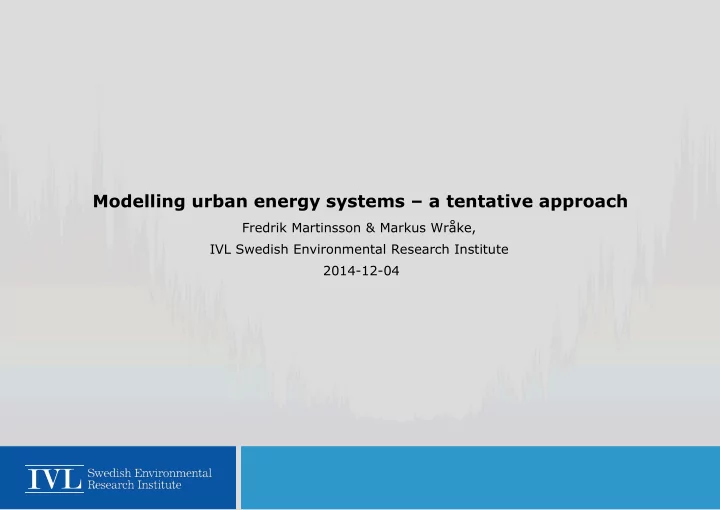

Modelling urban energy systems – a tentative approach Fredrik Martinsson & Markus Wråke, IVL Swedish Environmental Research Institute 2014-12-04
About IVL Independent status Operations span the whole field of sustainability Sweden ’ s broadest environmental expertise Both research and commission services Alliances and networks Laboratories and pilot plants Offices in Stockholm, Gothenburg, Malmö, Lysekil and Beijing, China Modelling urban energy systems – a tentative approach Fredrik Martinsson, 2014-12-04
Climate & Energy • Policy, decision support & climate strategies • Energy systems and interventions • Causation and effects • Renewable energy Modelling urban energy systems – a tentative approach Fredrik Martinsson, 2014-12-04
Agenda 1.General challenges – IVL outlook 2.Research questions – urban energy 3.Analytical approach - tentative Modelling urban energy systems – a tentative approach Fredrik Martinsson, 2014-12-04
Handling uncertainty and integration is key Uncertainty in demand patterns Uncertainty in System integration variability and – technology availability of VRE interdependencies Model requirements Presentation of uncertainties Modelling urban energy systems – a tentative approach Fredrik Martinsson, 2014-12-04
Challenges - regional/urban energy systems Characterizing future demand patterns Linkages Locational between energy aspects efficiency and supply options Model requirements Modelling urban energy systems – a tentative approach Fredrik Martinsson, 2014-12-04
Agenda 1.General challenges – IVL outlook 2.Research questions 3.Analytical approach Modelling urban energy systems – a tentative approach Fredrik Martinsson, 2014-12-04
Can a decentralised urban energy system enhance overall energy system efficiency? What is the most cost effective strategy for energy savings in buildings? Investment in How can different existing district definitions of NZEB heating or impact total transition to emissions and decentralized costs? energy system? Holistic approach – Impact of assessing total disruptive system efficiency technologies? Modelling urban energy systems – a tentative approach Fredrik Martinsson, 2014-12-04
Agenda 1.General challenges – IVL outlook 2.Research questions 3.Analytical approach Modelling urban energy systems – a tentative approach Fredrik Martinsson, 2014-12-04
Model approach Existing ”supply focused TIMES - models” use a highly aggregated building sector. – Drivers: Floor area demand for 2-5 building types – Loss of technical feasibility for the resulting energy service demand IVL/LTU TIMES buildings model – Archetype building approach – 10-100(?) buildings representing the building stock in a region – Finer representation of demand and technologies – Viable energy technology substitution options – More realistic costs of energy efficiency measures – A possibility to include the potential for demand flexibility Modelling urban energy systems – a tentative approach Fredrik Martinsson, 2014-12-04
Building model with archetype characteristics – Focus on existing stock • Physical properties of the buildings and their useful Archetypes energy demand (e.g., for space heating, hot water ) • Modelling assumes that a number of buildings can be assigned as being representative for the buildings stock Source: ZEN-n WP 3.1, http://zenn-fp7.eu / • Each archetype has an “individual” technology database Technology • Not all combinations of investments are plausible • Total effect of measures differs from the sum of each database individual – interdependency included •Tech option restriction: “Packages” of measures are created Source: www.knubix.com/ Modelling urban energy systems – a tentative approach Fredrik Martinsson, 2014-12-04
Capturing the feasibility of technical solutions and locational aspects (and more) Existing space Year of Energy use heating construction intensity technology Beskr iv två District Type of Person olika heating activity intensity possible arket yper Prerequisites Urban/Rural Climate zones for onsite RES Picture: ATON Teknikkonsult AB Archetype building X: Multifamily house Existing Internal Ventilation window heating from 1950-60 th systems performance distribution with district heating 2,4 pers/apt 170 kWh/m 2 Etc. Modelling urban energy systems – a tentative approach Fredrik Martinsson, 2014-12-04
The reference energy system and the technology substitution options – capturing feasibility Modelling urban energy systems – a tentative approach Fredrik Martinsson, 2014-12-04
Cost driven investments in energy efficiency measures in buildings – example 1. Archetype 1 - Package 1 1. Additional insulation in attics 2. Low energy lighting in stairways 3. Exhaust air heat pumps 4. Waste water heat recovery Package 2, etc. 5. New central ESX-ventilation system 6. New heat exchanger, circulation pumps, adjustments and optimising of heating and hot water circulation. 7. Individual metering hot water. 8. Supplementary insulation of facades 9. New energy efficient windows 10. New energy efficient elevators Source: ZEN-n, http://zenn-fp7.eu/ Modelling urban energy systems – a tentative approach Fredrik Martinsson, 2014-12-04
Each chosen “renovation package” will result in an individual load profile Cost 2 Cost 1 Modelling urban energy systems – a tentative approach Fredrik Martinsson, 2014-12-04
Questions to you What is your opinion about this approach? Ideas of how “flexibility” should be adressed? – Include on site RES in archetype building technology database? – How to include variable behavior of onsite RES in technology database in TIMES? – How include energy storage solution and running modes? – How to include DSM and load shedding? – How to avoid static non dynamic behavior ones included in the archetype chosen solutions? – Include stochastic behavior in net energy demand? Modelling urban energy systems – a tentative approach Fredrik Martinsson, 2014-12-04
Thank you for your attention! fredrik.martinsson@ivl.se markus.wrake@ivl.se www.ivl.se
Recommend
More recommend